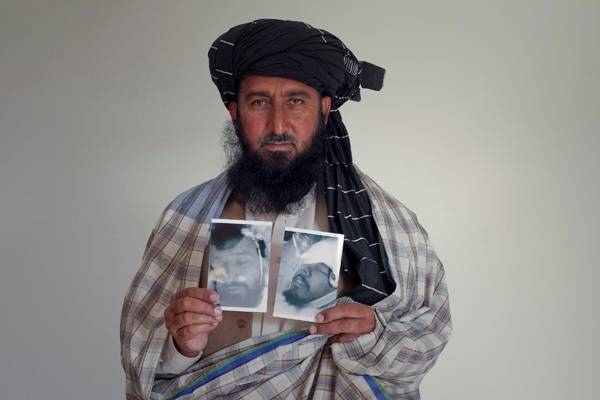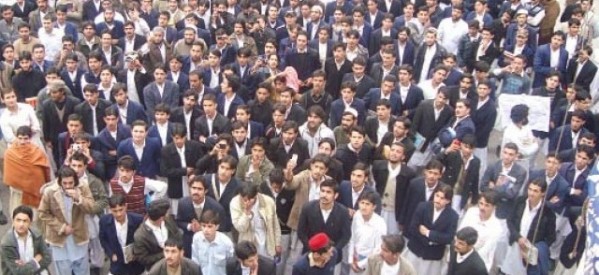by Zainab Syed and Arsalan Samdani
“They tortured me. They punched me on the head, they slap[ped] my arms and they beat me with a stick,” said Kareem Khan to journalists after his release from detention on February 13th.

Kareem Khan, 43, poses with images of his deceased brother Asif Iqbal (L) and son Zaenullah during an interview in Islamabad November 30, 2010. REUTERS/Mian Khursheed
Khan, a vocal anti-drone activist from FATA (Federally Administered Tribal Areas), was kidnapped (allegedly by Pakistan’s intelligence agency, the Inter Services Intelligence – ISI) from his home in the outskirts of Islamabad on February 5, 2014. This was just days before he was due to testify in front of European parliamentarians to further expose the impact of the US-led drone attacks in the northwestern Pakistan. After eight days of torture in an underground cell, he was released by being thrown out of a vehicle blindfolded.
“Some armed men in police clothes and plain civil uniform came in my house after midnight and took me with them,” Khan said about the identity of his captors.
After losing his teenage son and brother to a drone strike in North Waziristan in December 2009, Khan had launched a case in Pakistani courts implicating CIA members, including the CIA’s former station chief, in their deaths. Khan’s abduction was no surprise considering his role in exposing the atrocities committed by the US-led drone operations in northwestern Pakistan, and the collusion of the Pakistani authorities in this program. His kidnapping is further evidence of the extent of this collusion and the measures that Pakistan’s authorities are willing to take to suppress any voices that break through the barriers of silence placed on the people of FATA for the last six decades.
According to the Bureau of Investigative Journalism , as of 2014, millions of people have been displaced and at least 2,500 have been killed in drone strikes. Pakistan, being a ‘strategic ally’ of the US, has received more than $15.8 billion as security assistance in return for their compliance and support for US intervention in Central and South Asia.
After a renewed offensive launched in December 2013, which saw the bombardment of several neighborhoods in North Waziristan, the Pakistani government entered into negotiations with the Taliban under pressure from the people of Pakistan, allegedly to “give peace a chance.” These “talks” were unsuccessful, but many analysts have alleged that the government was not serious to begin with, and used the failure as a means to justify an alleged major offensive that would have resulted in the displacement of several thousand people, and many casualties.
The Pakistan army has entered into negotiations with the Taliban in the past, but these talks have been disrupted on numerous occasions. In June 2004, just two months after entering a peace deal with the Pakistan military, militant commander Nek Mohammad was killed in an attack for which the Pakistani military accepted responsibility, but it was later revealed that this was, in fact, the first drone strike of the region. Similarly, in November 2013, chief of the Pakistani Taliban, Hakimullah Mehsud, was killed in another drone strike just days after he had agreed to peace negotiations. This attack coincided with a US congressional hearing of drone victims that incited much public outcry and made international headlines.
FATA is a region which is still ruled by colonial laws that were meant to subjugate the local population, deny them any representation whatsoever, and legalize collective punishment by the state. As such, the area remains largely underrepresented and underdeveloped. Any voices, such as Kareem Khan’s, that venture to speak about the plight of the people of FATA are often violently suppressed by the authorities. This lack of voice and opportunity has contributed to radicalization and support for radical groups, that were once created by the state itself. Instead of addressing the causes of this radicalization, the state is resorting to violence to further silence the people of FATA.

“A large number of students hailing from FATA staged a protest demonstration on Jan 16, 2013 in front of Peshawar Press Club against the killing of eighteen innocent people in Tehsil Bara of Khyber Agency. The protesters had brought bodies of the deceased as evidence of their loss and as a way to demand action by the authorities. The Police fired tear gas and started aerial firing besides baton-charge to suppress the protest. “
Courtesy
FATA Research Center
Pakistan’s mainstream media is complicit in this suppression as they ignore the voices of the people of FATA . In response to these circumstances, organizers in Toronto have launched the Campaign Against Drones in Pakistan (CADiP). CADiP is a pro-people, anti-intervention and anti-imperialist campaign that seeks to shift public opinion and mobilize communities to take a stand against drone strikes in Pakistan and the imperialist wars in Afghanistan and Pakistan in general.
To learn more or to get involved:
http://www.cadip.info
Comments
Pingback: ‘Wounds of Waziristan’ Documentary Review | BASICS Community News Service